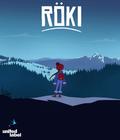The success of an adventure game rides or dies by its visual art style and narrative. In that regard, Polygon Treehouse's Röki shows promise. Playing as Tove, a young female lead, you must progress through dark, snowy forests of a Scandinavian-inspired environment to find your lost brother. From the get-go, the game makes its folklore inspirations known, for you are greeted by a many-eyed, talking tree at the start of the demo. The demo leaves the player with lots of vagueness, but it clearly alludes to a story that contains some type of parallel universe or cyclical time lapse.
The game mechanics are similar to other run-of-the-mill adventure titles. Players can click the left stick to highlight objects in the surrounding area. Interacting with objects may result in a simple observation from Tove, start dialogue with another character, or occasionally pick up key items. As expected from a game in this genre, the key items are added to your backpack, which the player can access at any time to see if the item can be used or combined with other items to unlock new areas and events. This game isn't going to revolutionize the adventure genre, but if you're into these sorts of games, there's a chance you'll enjoy Röki. If the idea of trying an item on eight different objects within the world until you find the right combination drives you nuts, then look elsewhere. That isn't going to change with this game.
The audio isn't mind-blowing, but it does enough to draw me in to the scenes within the game. Being a small studio from Cambridge, UK it's obvious why Polygon Treehouse elected to pass on voice-overs. While this would have been a great touch, they have given the various characters different sound bites, ranging from grunts to Simlish speak for the creatures and humans you meet. This helps set a subtle, yet effective tone during each of Tove's encounters. Melancholy sighs are expressed as she reads off the tombstones of deceased five-year-olds. The many-eyed tree sounds out a low drone to express his large, daunting presence. All of these sounds do just enough to convey the emotion in the text that sprawls across the screen as the story unfolds.
From a visual perspective, the art style has an intentionally flat but clean look, leaving out detailed shadows and instead dropping silhouetted objects in the foreground to give a sense of depth to the world. It's a common style used by a lot of indie developers in Unity engine games, and for good reason: It works. In Röki, the style works especially well due to the snowy environments the player traverses. The clean, understated color palette meshes well with the game's tranquil vibes. There were moments when this visual style was a bit jarring, though. One scene in particular has Tove speaking with a troll hiding beneath a bridge and away from the sun. Although mushrooms, rocks, and swords can be found scattered around and jutting from her shoulders, she mostly looks like one giant, amorphous, gray blob. It's a bummer, for one would hope the fictional folklore elements of the game would be the most captivating, but the art design misses the mark there.
Overall, I enjoyed my time previewing Röki Clocking in at just 15-20 minutes, the demo is quite short and ends rather abruptly, but I hope Polygon Treehouse has a lot more to unveil. There are hints of a complex story that delves into time paradoxes and a setting steeped in Scandinavian folklore, so I'm intrigued to check out the full game upon its release in 2020, but at the same time, paradox narratives rarely wrap up in a satisfying manner. They're usually confusing or full of plot holes — or both. Nevertheless, my curiosity has been piqued, and I'm hopeful that Polygon Treehouse can deliver a meaningful and clear story in Röki.
More articles about Röki











 Röki is an adventure game about a young girl venturing deep into the forbidden wilderness, a land of dark mystery, ancient magic and monsters.
Röki is an adventure game about a young girl venturing deep into the forbidden wilderness, a land of dark mystery, ancient magic and monsters.










